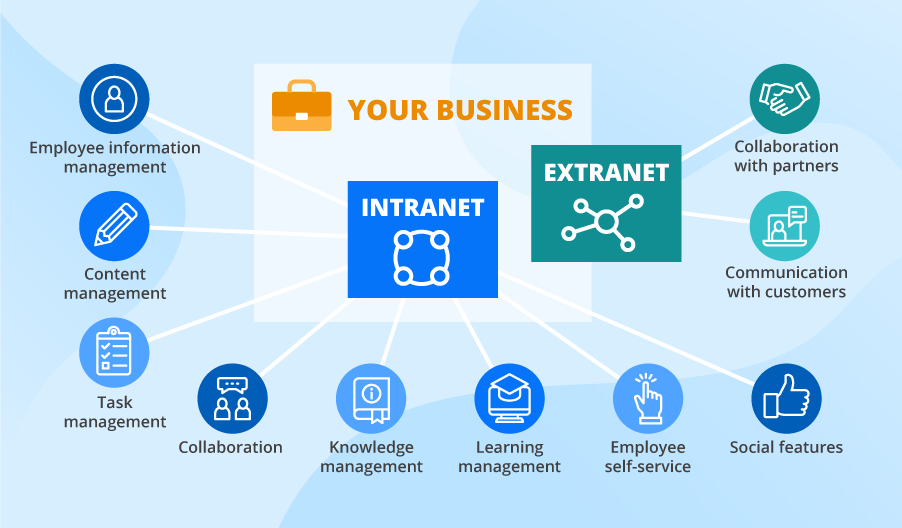In 2021, the percentage of companies switching to remote work has drastically increased. This makes businesses turn to implementing intranets and extranets to organize collaboration among employees, as well as with customers and partners. For example, 70% of companies consider an intranet valuable or very valuable to their employees, while extranets are widely used among the B2B community.
What is an intranet?
According to Gartner, an intranet uses techniques similar to the internet, but it can be accessed only by a company’s employees. Intranets offer features to address internal communication and collaboration, project and task management. For example, in an intranet, employees can track the latest project updates and important business news.
Intranets are widely used in onboarding. For example, they can provide multimedia training tools for intro learning and collaboration tools for new hires and their tutors.
An intranet’s key functionality includes:
- Employee information management. Employees can edit their profiles that contain both personal (e.g., a name, an address, contacts) and work-related information (e.g., a position, a department, qualifications).
- Content management. Intranets not only serve as a source of information but also allow users to create, modify and publish various digital content (e.g., documents, news, guides, policies).
- Project and task management. Project teams can use an intranet to track project and tasks, including progress, deadlines, related documents and discussions, and more.
- Employee collaboration and communication. Intranets offer department and team sites for effective collaboration on projects, tasks, and documents as well as provide communication tools (e.g., instant messaging and video conferencing).
- Knowledge management. Intranet users can process, store, improve, make corporate knowledge easily accessible and actively reused.
- Learning management. Intranets provide creating, scheduling and delivering trainings to employees, including knowledge assessment and certification. Also, employees can enroll into a relevant training via an intranet.
- Employee self-service. Employees can submit various requests (e.g., vacation, equipment maintenance, training) via an intranet and track their fulfillment.
- Social features. These intranet features help improve employee engagement and motivation. They include integration with social media, forums, blogs, mentions, comments, likes, surveys, communities, and gamification features like badges, points, and leaderboards.
What is an extranet?
Extranets connect organizations with their suppliers, customers, business partners, or other third parties. They help engage external participants in internal business processes, for example, to streamline procurement operations and support a real-time supply chain.
An extranet’s key functionality includes:
- Collaboration with partners. These features include bid management, vendor assessment and approval workflows, and more (for vendor portals).
- Communication with customers and customer self-service. Customers can place service requests and track their resolution, find answers to their questions about your product or service in a knowledge base, exchange ideas and opinions about your brand via discussion boards.
Benefits of using an intranet
- Efficient employee communication and collaboration. Such features as chats, discussion boards, real-time collaboration on documents, and more allow your employees to stay in touch even if they’re working remotely.
- Facilitated project management. Project teams can create, modify, and notify their members about task updates via an intranet. And project managers can track the project progress and assess the team’s performance.
- Increased employee productivity. Using one digital workspace saves time and effort otherwise spent on switching between disparate tools (e.g., email, video conferencing applications, messengers, project management software), which helps improve employee productivity.
Benefits of using an extranet
- Facilitated business process management. Extranets allow automating processes like vendor assessment and approval, order placement, billing, and more. Besides, your customers and partners get access to the information you want to share with them without calling or emailing you.
- Corporate and personal data safety. An extranet is a more secure way to exchange data than, for example, an email, as it offers granular access control, multifactor authentication, encryption of data at rest and in transit, audit trail, and other security measures.
- Improved visibility into business operations. With an extranet, you can see every action taken, let’s say, during the order fulfilment, as well as who did them. This makes the whole process traceable and enhances quality control.
Intranet vs. extranet
An intranet can become a suitable solution for creating a safe digital working environment for your employees, increase employee motivation, and strengthen the sense of community.
An extranet, in its turn, can enable remote collaboration with your customers, vendors and partners and save the time and efforts of all the parties via automation and creating full visibility into the collaboration process.
Facilitate employee and business collaboration
It might be overwhelming to choose intranet or extranet functionality that would be enough to meet your business needs, implement, and support your solution. If you need help with any of these tasks, feel free to contact Scs Tech team.
